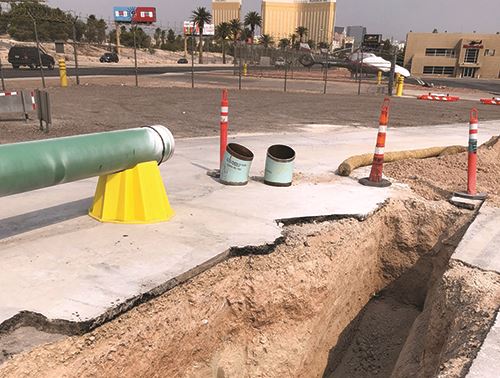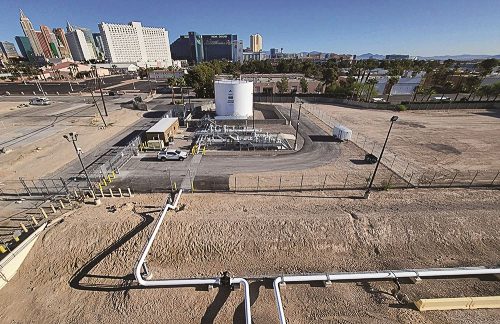A 3.5-mile pipeline snaking beneath the streets of Las Vegas is the final component of a multi-phase fuel system project at Harry Reid International Airport (LAS), formerly known as McCarran International. The roughly $70 million initiative, funded entirely by the local fuel consortium, dates back to the early 2000s, when Clark County Department of Aviation began looking for ways to expand storage and throughput of the system that feeds aviation fuel to LAS and four smaller airports that serve Southern Nevada.
A 3.5-mile pipeline snaking beneath the streets of Las Vegas is the final component of a multi-phase fuel system project at Harry Reid International Airport (LAS), formerly known as McCarran International. The roughly $70 million initiative, funded entirely by the local fuel consortium, dates back to the early 2000s, when Clark County Department of Aviation began looking for ways to expand storage and throughput of the system that feeds aviation fuel to LAS and four smaller airports that serve Southern Nevada.
 Decades of hard work and thoughtful coordination came to fruition in March, when the new pipeline began operating in conjunction with upgraded tanks and other infrastructure improvements added in prior phases of the long-term initiative. As a second in command at LAS, Deputy Director of Aviation Jim Chrisley has been hands-on with the effort his entire six and a half year-tenure with the airport.
Decades of hard work and thoughtful coordination came to fruition in March, when the new pipeline began operating in conjunction with upgraded tanks and other infrastructure improvements added in prior phases of the long-term initiative. As a second in command at LAS, Deputy Director of Aviation Jim Chrisley has been hands-on with the effort his entire six and a half year-tenure with the airport.
“The new fuel pipeline serving LAS and our general aviation airports is a project that has been in development for close to 20 years,” Chrisley says, adding that LAS was the eighth-busiest U.S. airport for passenger traffic in 2021. “We are certainly a leader in origin and destination traffic, which gives rise to a lot of unique challenges that resonate throughout the airport’s operations. Fueling the planes is certainly one of them.”
|
Project: Fuel Pipeline Airports Served: Harry Reid Int’l; Henderson Executive; Jean Sport Aviation Center; North Las Vegas Airport; Perkins Field Length: 3.5 miles Associated Improvements: New storage tanks & upgraded infrastructure Phase I: $30 million for 65,000-barrel tank, improved system controls & larger electrical building Phase II: $40 million for trio of 100,000-barrel replacement tanks, new pump filtration system & new load rack and pipeline New Storage Capacity: 502,134 barrels (enough fuel for 18.5 days of operations) Project Timeline: Planning began in 2005, Phase I construction completed in 2011; new pipeline operational in March 2022 System Owner: LASFuel airline consortium Construction Manager: Argus Consulting Operator: Swissport Fueling Services General contractors: New-Com Inc. – MMC- ACME Electrical Engineering Facilities & Pipeline: Spec Services Inc. Engineering & Permitting: TY Lin
Public Outreach (Pipeline ROW): Key Benefit: Increased on-airport fuel storage & throughput capacity |
Looking Forward
In 2005, the Clark County Board of Commissioners established a Blue Ribbon Commission to study future fuel needs for the entire region, including all five airports in the county as well as Nellis Air Force Base. Working in conjunction with LASFuel, the local airline consortium, the commission determined that it was prudent to maintain a readily available 15-day supply of aviation fuel. The annual fuel growth for LAS is estimated at 1.5% year over year.
“Las Vegas is probably one of the most geographically separated population centers in the U.S., and that presents us with some unique challenges,” says Chrisley. “If the fuel stops flowing for any reason, we’re only a few weeks away from being unable to fuel planes, which would have a major impact on a key driver of Southern Nevada’s economic engine.”
The commission’s report, completed in November 2006, recommended a series of fuel system improvements to increase onsite storage capacity and overall throughput. Phase I, completed in 2011 at an approximate cost of $30 million, included the installation of a 65,000-barrel tank to replace two existing tanks. Improved system controls and a larger electrical building were also added. Combined, the Phase I improvements increased the usable on-airport fuel storage capacity by 25%, from 234,278 barrels to 292,890, which equated to 13.9 days of fuel.
During Phase II, contractors installed three 100,000-barrel replacement tanks and a new pump filtration system. They also replaced the load rack to make room for the new larger tanks. This increased the on-airport fuel storage capacity from the nearly 293,000 barrels achieved in 2011 to 502,134 barrels—the equivalent of 18.5 days of usable aviation fuel. Phase II costs were approximately $40 million.
Getting It Done
As president of LASFuel, Nolan Getty has had his hands full overseeing stakeholder interests in the pipeline improvements program. The consortium alone includes 27 airlines, and several other entities are affected by the project, too.
“LASFuel is a consortium of member airlines working together as a non-profit corporation to manage our fuel interests at LAS,” says Getty, who works for Southwest Airlines, the largest fuel consumer at LAS. “Our member airlines are directly aware of fuel supply and demand and have a vested interest in the buying power, operational efficiency and increased system capacity working together affords us.”
In short, he sees the consortium’s role as vital for fiscal responsibility and situational stability in the large-scale fuel management needed at LAS. That’s why LASFuel took the driver’s seat regarding the new tanks, system upgrades and, most recently, the new pipeline.
 “Pre-COVID, there were days when the airlines serving LAS were consuming more fuel than we were able to pipe in. We understood that the limitation was fuel system infrastructure,” Getty explains. “When the idea to improve the infrastructure began to take shape, LASFuel determined that it was to our advantage to own the system we rely on. This gives us control over future upgrades, reduces long-term costs, and eliminates throughput fees we would otherwise be paying to an operator forever.”
“Pre-COVID, there were days when the airlines serving LAS were consuming more fuel than we were able to pipe in. We understood that the limitation was fuel system infrastructure,” Getty explains. “When the idea to improve the infrastructure began to take shape, LASFuel determined that it was to our advantage to own the system we rely on. This gives us control over future upgrades, reduces long-term costs, and eliminates throughput fees we would otherwise be paying to an operator forever.”
The 27 members of the consortium pooled their resources to fund the $70 million of improvements required to bring the new fuel system online, but getting it designed and built required more than money. The task of constructing multiple miles of steel pipeline through one of the biggest entertainment capitals of the world was no small undertaking.
“The existing pipeline varied in diameter from 12 inches to just 6 inches, which resulted in a bottleneck in the line,” Getty explains. “This project replaced that with a 16-inch bypass line that eliminates the bottleneck and increases the rate and volume of fuel that can be received at one time. However, there was a significant amount of red tape to get through along the way. That’s where our partnership with Argus became a real asset.”
 As one of leading fueling infrastructure engineering firms in North America, Argus Consulting tapped into its experience in aviation and several other industries to tackle the LAS pipeline project. In addition to acting as construction manager, Argus also served as a project advisor before construction began. Dan Liss, director of Asset Management Services for the firm, has had the Las Vegas pipeline on his plate for the last 10 years.
As one of leading fueling infrastructure engineering firms in North America, Argus Consulting tapped into its experience in aviation and several other industries to tackle the LAS pipeline project. In addition to acting as construction manager, Argus also served as a project advisor before construction began. Dan Liss, director of Asset Management Services for the firm, has had the Las Vegas pipeline on his plate for the last 10 years.
“The LASFuel pipeline project is an excellent example of the coordination, communication and genuine partnership required by all parties to get a project like this designed, built, commissioned and operational,” says Liss. “Under the best circumstances, this is a challenging situation. With COVID-19 going on, every challenge was magnified exponentially.”

When reflecting on the complex endeavor, Liss, Getty and Chrisley all point to permitting as the biggest hurdle the team had to overcome. With construction originally scheduled to start in late 2019, most of the materials needed to build the pipeline were purchased before COVID severely hampered supply chains. However, securing permits for all of the necessary intrusions to the community’s existing infrastructure became far more complicated when the pandemic eliminated in-person interaction.
“Whenever you open-cut a major street in the middle of a city, you never know what you’re going to find,” adds Liss. “In Las Vegas, we found old electrical lines, water lines, sewer lines and drainage apparatus that we had to navigate around. Building over, under and around these things required a lot of coordination with third parties, not to mention a dedicated traffic plan to keep people moving in a city that never takes a night off.”

Steve Waag, Argus founder and former owner’s representative for LASFuel, served as a technical advisor for the project since 2005. Along the way, he played a key role in securing right-of-way access for the pipeline and other fundamental precursors to construction.
“Property acquisitions, crossing the jurisdictions of railroads, utilities and others takes a tremendous amount of planning and coordination,” says Waag, who retired in September 2021 after more than 40 years in the aviation fuel industry. “From the studies that were done to increase storage capacity in 2005 to pumping fuel in the spring of 2022 represents a lot of work by a lot of people. It’s fantastic to see it finally come to fruition.”

Waag, Liss, and Getty all praise the airport for great partnership during the implementation process, especially once the pipeline crossed onto LAS property. For example, the airport allowed contractors to perform much of their airfield work at night in order to limit the impact of construction on the traveling public. The airport also took the lead coordinating with the FAA.
All the coordination and planning were rewarded in March, when the airport, LASFuel, Argus and system operator Swissport Fueling Services celebrated completing the pipeline with a sense of triumphant elation.
“The LASFuel pipeline has been a long, and at times challenging, journey,” Chrisley reflects. “Increasing the throughput and capacity to store fuel in advance of need puts LAS in position to weather any short-term storm or supply shortage now and into the foreseeable future. A team commitment to communication, collaboration and continual forward progress has been essential to success. Despite the challenges, the peace of mind this project affords the airport and airlines is invaluable. This is an accomplishment we can all be proud of.”


 facts&figures
facts&figures

